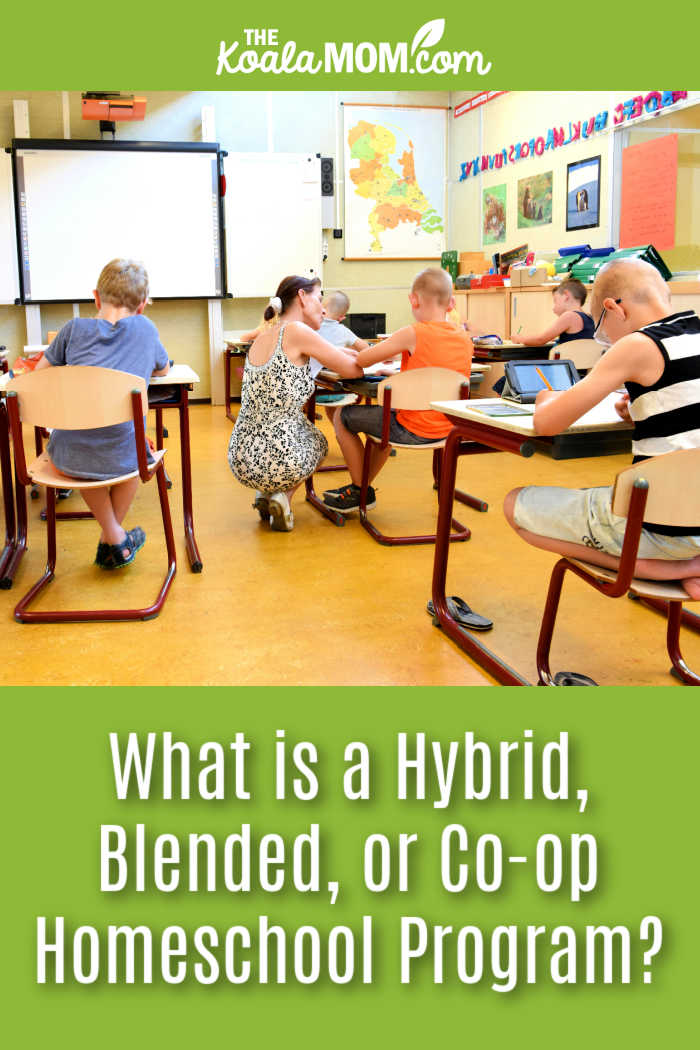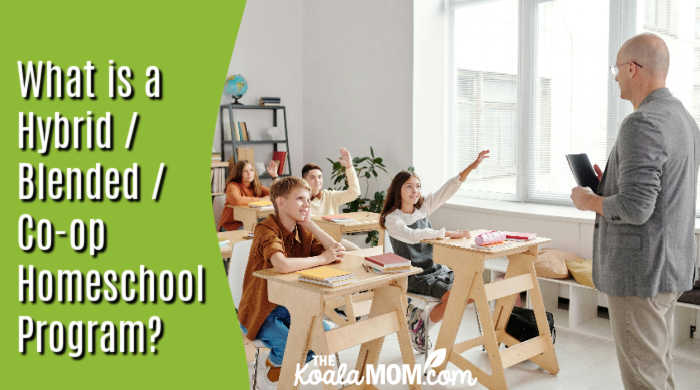These days, children have access to a variety of educational options, from public to private school, online schooling to homeschooling, and even a mix of these. In some areas, schools offer blended or hybrid programs or homeschool co-ops which combine home learning days with classroom days. If you are wondering about the pros and cons of these programs, read on.
My kids have spent the bulk of their school years as traditional, full-time homeschoolers. We’ve also done homeschool co-ops during various years. Currently, my oldest two are in full-time Catholic high school while my younger three are in a blended homeschool program. I spend a lot of time thinking about what works for them and our family, and also check in with my kids regularly about what they like about their school days and what they want to continue doing or change.

This post contains affiliate links; as an Amazon associate, I earn from qualifying purchases.
What is a Hybrid / Blended Homeschool Program?
Hybrid or blended school programs are a mix of in-person classroom days and at-home learning. These programs vary by school, but usually follow the local school calendar with set days that children attend classes at a specific location. Classes are usually small (around a dozen kids) and are offered on specific subjects, such as science and physical education. Classes may be split across multiple grades or include a wider variety of age groups than public schools.
While a hybrid / blended program is attached a specific school, a homeschool co-op usually refers to a group organized by parents. For example, I organized a homeschool co-op with several fellow homeschooling moms for a year to cover Canadian history with our children. We had about five families involved and met every second week for field trips, group activities, projects and presentations, and more. It made some parts of the teaching easier for us as moms and some parts of the learning more exciting for our children.
Some schools may also offer community classes for homeschool students. These are usually one-off classes that are offered on a specific subject (such as a science topic or a writing class) at a specific time and place. Children can register for the one class and do the rest of their learning at home. Sometimes, local arts centres or recreation centres offer classes like this that meet homeschooling criteria for a specific topic.
Advantages of Blended Homeschool Programs
Spending a day or two per week in the classroom offers homeschool children the opportunity to make friends and participate in group activities. Some learning experiences, such as sports, are simply best if there’s more than one or two children. Teachers can set up debates and presentations, class projects, field trips, and more when there is a larger group of children.
Children also get the chance to learn from a teacher other than their mom. I’ll be the first to admit that while I love homeschooling my children, there are limitations to my knowledge (and patience). Another teacher can offer fresh ideas, a new perspective, or a different way of teaching that may click with your child. I’ve found my kids are often willing to work harder when a teacher assigns certain projects or when they know their peers are counting on them to get something done.
The school may be able to offer learning toys and tools that are expensive to acquire at home. For example, schools may have microscopes and specimens for science experiments or tech toys such as Snap Circuits or robotics kits. The teacher may also have access to certain online learning resources with a teacher or school discount.
Having children in school for a day or two per week can offer mom a break. For moms homeschooling multiple kids, or trying to work from home, this can be a huge help. Many moms face homeschool burnout and having a day off can help prevent that. I try to book my appointments for days when my kids are at school and to get as much work done as I can so that I’m better able to focus on them during the days that we have together to do school.
Disadvantages of Hybrid Homeschool Programs
Spending time in the classroom reduces the flexibility of homeschooling. Other activities now need to be planned around the classroom days. This means my children have sometimes missed out on other opportunities that happen during the school days. We’ve also been unable to plan trips during the school year; before starting a local blended program, we’d spend a week in September camping with my mom and one year spent December in Alberta due to my grandfather’s passing.
There may be a greater cost associated with hybrid homeschool programs, due to the need to pay for classroom space and a teacher. Here in BC, government funding does not fully cover this cost, so parents pay an additional tuition fee. This varies by the school, and the schools usually offer monthly payment options, but it also means funding is unavailable for curriculum as well.
Classroom days mean kids need to pack a lunch and be out the door at a specific time. As long-time homeschoolers, this has been a big learning curve for us. We now have a working morning routine for school days, but it has taken a while (and a few late arrivals) to get there. We’ve gotten better at packing school lunches too, although there are still days when my kids can’t decide what to put in their lunch bag and get frustrated that they can’t just reheat their favourite leftover at school.

Blended Homeschool Programs in the Lower Mainland
There is a large and vibrant homeschooling community here in the lower mainland, which means that there are also numerous programs available to homeschoolers.
- TLA Online offers one- and two-day blended programs in Surrey and Vancouver, as well as community classes and traditional homeschooling support.
- Hume Park School offers a two-day blended program in New Westminster.
- Heritage Christian Online School offers in-person community classes for one or half day per week.
- Regent Christian Online School offers in-person instruction and school clubs across the lower mainland.

No Responses Yet